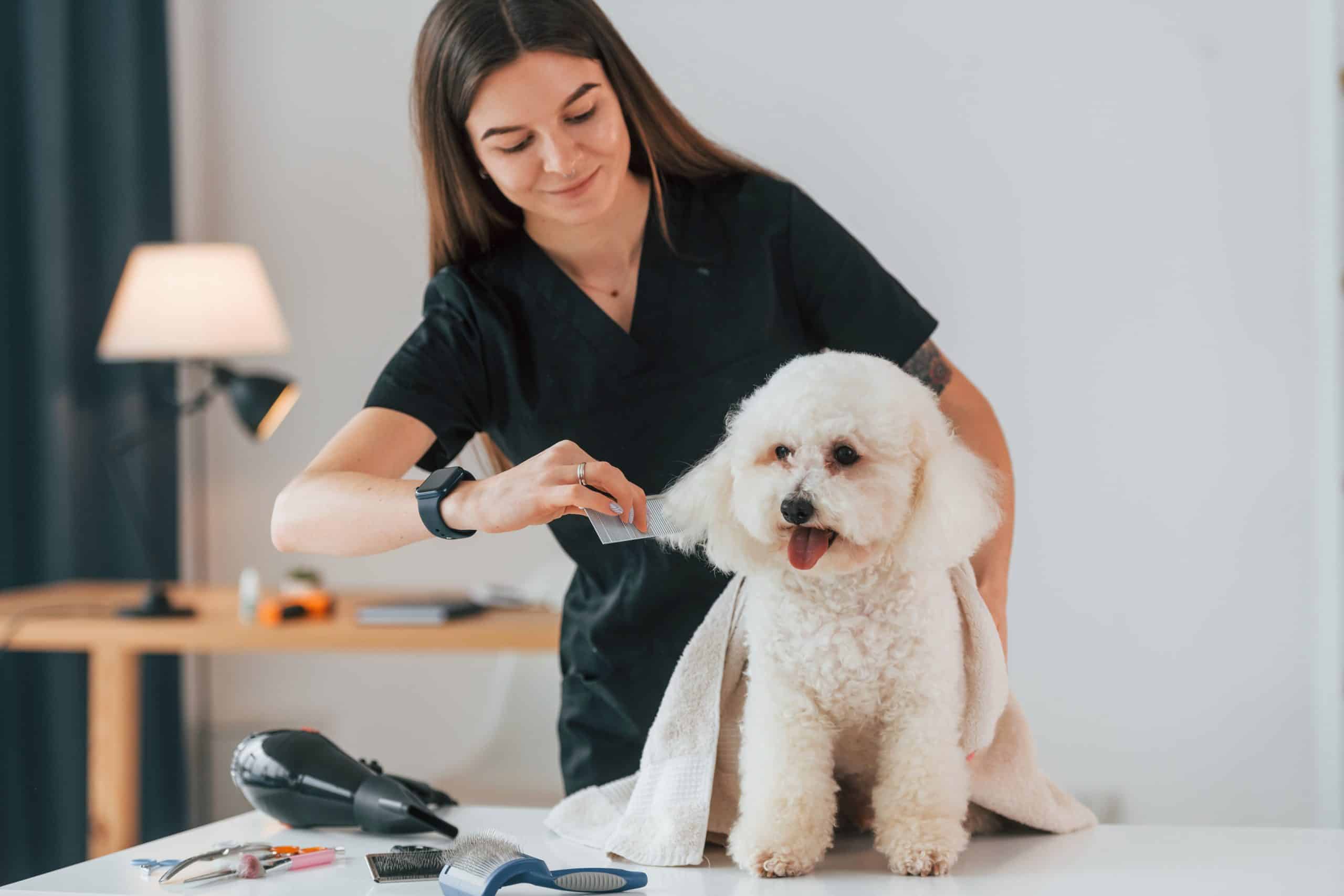How to Develop a Grooming Routine for a Dog with Sensitive Skin?

Taking care of a pet, especially a dog, involves much more than providing food, water, and shelter. Regular grooming is also necessary to maintain the dog’s health and appearance. However, if your dog has sensitive skin, the grooming routine may need to be handled differently to avoid causing discomfort or aggravating the problem. In this article, we’ll provide you with insights and tips on how to develop a grooming routine for a dog with sensitive skin.
Understanding the Dog’s Coat
Before diving into the specifics of the grooming routine, it’s essential to understand the type of coat your dog has. Dogs have different types of coats, such as short, long, smooth, wiry, curly, or double-coated. The condition and type of your dog’s coat can give you a clue about the state of their health, and it can also shed light on how to approach their grooming.
Lire également : How to Optimize a Living Space for a Parrot to Reduce Stress and Anxiety?
Even though the coat type may differ, all dogs have skin that can be sensitive, and it’s crucial to recognize this fact. Sensitive skin in dogs can be caused by various factors such as allergies, parasites, poor diet, or underlying health conditions. If your dog has sensitive skin, you’ll likely notice symptoms such as itchiness, redness, flaking, sores, and patches of hair loss.
When dealing with a sensitive-skinned dog, it’s essential to consult your vet to identify the root cause and address it promptly. Once you understand your dog’s coat type and the underlying skin issues, you can then develop a grooming routine that will be both beneficial and comfortable for your pet.
Lire également : What’s the Best Technique for Introducing a Service Dog to Public Transport?
Brushing Your Dog’s Hair
Brushing your dog’s hair is a vital part of the grooming routine. Regular brushing helps to keep the coat clean, untangled, and free from mats. For a dog with sensitive skin, brushing also stimulates the skin and spreads natural oils, promoting a healthy and shiny coat.
However, the approach to brushing may need to be adjusted for a dog with sensitive skin. When brushing, be gentle and avoid tugging on the hair or scraping the skin. Use a brush designed for dogs with sensitive skin, and consider using a detangling spray to make the process easier.
The frequency of brushing will largely depend on the type of coat your dog has. Short-haired dogs may need brushing once a week, whereas long-haired dogs may require daily brushing. Regardless of the frequency, ensure to make each brushing session a positive experience for your pet to help them associate it with pleasant feelings.
Bathing and Using the Right Shampoo
Bathing your dog is another essential aspect of grooming. Regular baths help to keep your dog’s coat and skin clean, reducing the risk of infections. When bathing a dog with sensitive skin, the choice of shampoo is crucial.
Opt for hypoallergenic or sensitive skin shampoos that are free from harsh chemicals and fragrances, as they can irritate the skin. You can also consider medicated shampoos if recommended by your vet. When bathing, ensure the water is lukewarm, and avoid getting water in the dog’s eyes, ears, or nose.
The frequency of baths will depend on your dog’s lifestyle and breed. Some dogs may require weekly baths, while others may only need a bath once a month. Always ensure to rinse thoroughly to remove all soap from the coat, as remnants can cause skin irritation.
Nail Care
Nail care is another element of the grooming routine that should not be overlooked. Overgrown nails can be uncomfortable for your dog and can lead to walking difficulties or injuries. For a dog with sensitive skin, it’s even more critical to handle nail trimming with care to avoid causing any discomfort.
Always use a sharp, high-quality dog nail clipper to ensure clean cuts. If your dog has clear nails, look for the quick, which is a visible blood vessel, and avoid cutting into it. For dogs with dark nails, trim a little at a time to avoid cutting into the quick. If you’re unsure about trimming your dog’s nails, consider seeking help from a professional groomer or your vet.
Regular Vet Visits
Keeping up with regular vet visits is crucial for maintaining your dog’s health, especially if they have sensitive skin. Your vet can provide guidance on the best grooming practices, recommend suitable products, and monitor your dog’s skin condition.
During the vet visits, ensure to discuss any concerns you may have about your dog’s skin. Always remember, the best approach to grooming a dog with sensitive skin is one that combines your efforts with professional input. Regular vet visits will ensure that any skin issues are detected and addressed promptly, which will in turn help to keep your dog comfortable and happy.
Remember, taking care of a dog with sensitive skin requires patience, consistency, and understanding. But with time and the right grooming routine, you can help your pet stay clean, comfortable, and healthy.
Selecting Appropriate Grooming Tools and Products
The right grooming tools and products play a significant role in taking care of a dog with sensitive skin. The choice of grooming tools will largely depend on your dog’s coat type. However, when dealing with dogs with sensitive skin, always opt for softer brushes and combs that won’t scrape the skin or cause any discomfort.
Alongside brushes and combs, grooming gloves can be a great addition to your grooming routine. These gloves can help distribute natural oils across the dog’s coat while providing a gentle massage that your furry friend will likely enjoy.
When it comes to grooming products, it’s vital to select those specifically designed for dogs with sensitive skin. Shampoos and conditioners should be hypoallergenic, scent-free, and devoid of harsh chemicals that could cause skin irritation. It’s also wise to invest in a quality, sensitive skin-friendly paw balm to keep your dog’s paw pads healthy.
Always remember to consult with your vet or a professional groomer when choosing grooming tools and products. They can provide specific recommendations tailored to your dog’s unique needs. Furthermore, always introduce new products slowly and monitor your dog’s skin for any adverse reactions.
Diet and Exercise: Essential Aspects of Dog Skin Care
A healthy diet and regular exercise are also vital for maintaining your dog’s skin health. Your dog’s diet can significantly affect their skin and coat health. Dogs with sensitive skin may benefit from a diet rich in omega-3 and omega-6 fatty acids, which help to nourish the skin and keep it hydrated.
Feed your furry friend a balanced diet that includes high-quality protein sources, fruits, vegetables, and healthy fats. Avoid foods that your dog is allergic to, as these can trigger skin reactions. If you’re unsure about the best diet for your dog, consult with your vet. They can provide diet recommendations based on your dog’s age, breed, weight, and health status.
Exercise helps to improve your dog’s overall health, including skin health. Regular physical activity promotes good circulation, which aids in skin and coat health. Moreover, exercise can help reduce stress in dogs, which can be a trigger for skin issues in some dogs.
Conclusion
Developing a grooming routine for a dog with sensitive skin can be a daunting task, but with the right approach, you can ensure your pet is comfortable and their skin remains healthy. It involves understanding your dog’s coat type, choosing the right grooming tools and products, regular brushing, bathing, nail care, and keeping up with vet visits.
Moreover, a healthy diet and regular exercise are essential aspects of skin care that should not be overlooked. Remember, consistency and patience are key to successfully groom a dog with sensitive skin. Always consult with professionals if you’re unsure about any aspect of the grooming process, and be ready to adjust the routine as needed based on your dog’s needs.
In the end, your efforts will help keep your furry friend comfortable and happy, enhancing the bond between you and your pet. Regular grooming is not only necessary for maintaining your dog’s physical health but also serves as a means of showing love and care for your loyal companion.
